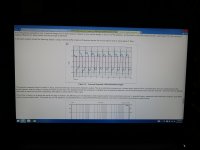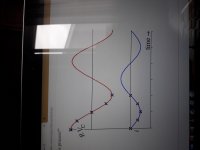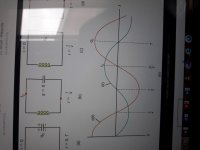Tubecad has an interesting article on 1st, 2nd, and 3rd order series 2way crossovers here...
Series Vs Parallel Crossovers
Which raises the question: can this type of thing be expanded to a three way application?
Series Vs Parallel Crossovers
Which raises the question: can this type of thing be expanded to a three way application?
In principle you can have exactly as many crossover points with series as you can with parallel. However, it becomes increasingly difficult since with series filters, where everything is in circuit, if you change one component there's a high chance it will affect everything else too. You can model them in crossover simulators, same as any other filter, but they usually take longer to optimise.
One point about those tubecad pages -nice diagrams &c., but remember the simulations are done exclusively as electrical transfer functions, with zero accounting for phase, driver positions, and innate driver frequency, impedance responses, distortion performance, dispersion &c.
One point about those tubecad pages -nice diagrams &c., but remember the simulations are done exclusively as electrical transfer functions, with zero accounting for phase, driver positions, and innate driver frequency, impedance responses, distortion performance, dispersion &c.
For me, it started 8 years ago. I was getting frustrated. I couldn't get my parallel crossovers to sound perfect, nor did I hear perfection at any of the Audio Shows. You can guess at some of the prices.
I happened upon an article. It was by Elliot Sound Productions (esp?). Series vs Parallel.
There was a graph. ESP input a square wave into a series crossover, out came a square wave. ESP input the same square wave into a parallel crossover, out came something else. I postulated; female voice in, female voice out (series crossover) vs. female voice in, something else out (parallel crossover).
The 'sound' from a series crossover is different from a parallel crossover. This difference increases with volume. For me, who likes his music loud, there's no going back.
I caution you;
-the drivers must be well behaved. There is no way of adding correction circuits without ruining the magic of a series crossover.
-the back emf of the woofer may pose a problem. Choose a woofer with low Le.
-even with a 2nd order L-R series crossover, there is still a fair bit of overlap. Choose a smallish midrange (2-4"), crossed at 4Khz or higher to the tweeter. During testing, adjust the depth of the tweeter for time alignment. You should spend a fair bit of time on this. No words can stress it's importance.
Conduct a quick experiment. Take a speaker you've already built, throw a series crossover together. Listen. If you can hear/sense the improvement immediately, series is for you. If you can't hear/sense any difference, than it doesn't really matter.
Series crossovers require the right drivers. The 2" - 4" midrange being the most critical. I compiled a short list a few years ago. I'll try to find it.
I happened upon an article. It was by Elliot Sound Productions (esp?). Series vs Parallel.
There was a graph. ESP input a square wave into a series crossover, out came a square wave. ESP input the same square wave into a parallel crossover, out came something else. I postulated; female voice in, female voice out (series crossover) vs. female voice in, something else out (parallel crossover).
The 'sound' from a series crossover is different from a parallel crossover. This difference increases with volume. For me, who likes his music loud, there's no going back.
I caution you;
-the drivers must be well behaved. There is no way of adding correction circuits without ruining the magic of a series crossover.
-the back emf of the woofer may pose a problem. Choose a woofer with low Le.
-even with a 2nd order L-R series crossover, there is still a fair bit of overlap. Choose a smallish midrange (2-4"), crossed at 4Khz or higher to the tweeter. During testing, adjust the depth of the tweeter for time alignment. You should spend a fair bit of time on this. No words can stress it's importance.
Conduct a quick experiment. Take a speaker you've already built, throw a series crossover together. Listen. If you can hear/sense the improvement immediately, series is for you. If you can't hear/sense any difference, than it doesn't really matter.
Series crossovers require the right drivers. The 2" - 4" midrange being the most critical. I compiled a short list a few years ago. I'll try to find it.
Attachments
It might at this point be worth mentioning that
a/ Only 1st order filters & variations thereof can reproduce square waves (whether this is of any relevance to loudspeakers is debatable). It does not apply to higher order filters. And
b/ The ability to reproduce a square wave is not exclusive to series 1st order filters, since parallel 1st order can do it also, Joe Rasmussen's Elsinore being a prime example.
Personally I've never found any magic to series filters of any description, just the same old science that everything else conforms to. If you're hyper-minimalist then 1st order series, as suggested by the Elliot Sound page, is probably slightly superior to 1st order parallel as it has greater immunity to impedance variations in the drivers at the expense of the XO frequency shifting about somewhat. On the other hand, it could be reasonably argued that a competently designed speaker does not allow driver impedance variations to disrupt behaviour in the first place.
Presumably if one throws a series filter together for an existing speaker as recommended above, this filter must be tracking the original transfer functions? If not, any attempt at comparison between series and parallel filter topologies is instantly rendered utterly meaningless since you are not comparing like with like: you're comparing completely different crossover slopes (and possibly frequencies) with the attendent potential deviations in frequency, phase, dispersion and distortion responses.
a/ Only 1st order filters & variations thereof can reproduce square waves (whether this is of any relevance to loudspeakers is debatable). It does not apply to higher order filters. And
b/ The ability to reproduce a square wave is not exclusive to series 1st order filters, since parallel 1st order can do it also, Joe Rasmussen's Elsinore being a prime example.
Personally I've never found any magic to series filters of any description, just the same old science that everything else conforms to. If you're hyper-minimalist then 1st order series, as suggested by the Elliot Sound page, is probably slightly superior to 1st order parallel as it has greater immunity to impedance variations in the drivers at the expense of the XO frequency shifting about somewhat. On the other hand, it could be reasonably argued that a competently designed speaker does not allow driver impedance variations to disrupt behaviour in the first place.
Presumably if one throws a series filter together for an existing speaker as recommended above, this filter must be tracking the original transfer functions? If not, any attempt at comparison between series and parallel filter topologies is instantly rendered utterly meaningless since you are not comparing like with like: you're comparing completely different crossover slopes (and possibly frequencies) with the attendent potential deviations in frequency, phase, dispersion and distortion responses.
Let's look at a sine wave (music).
What does a single capacitor do to the waveform? I will assume we all know this will apply to the tweeter (in a 2-way), tweeter and midrange (in a 3-way), etc.. A single inductor on a woofer will have the same effect, but shifted. Let's stick with the tweeter's capacitor.
A single capacitors affect on the sine wave. This crossover is asymmetrical (both pictures). The 2nd order L-R series crossover (which adds a second capacitor, on the -ve leg) is symmetrical. Can you hear the difference?
Build it, listen, decide.
What does a single capacitor do to the waveform? I will assume we all know this will apply to the tweeter (in a 2-way), tweeter and midrange (in a 3-way), etc.. A single inductor on a woofer will have the same effect, but shifted. Let's stick with the tweeter's capacitor.
A single capacitors affect on the sine wave. This crossover is asymmetrical (both pictures). The 2nd order L-R series crossover (which adds a second capacitor, on the -ve leg) is symmetrical. Can you hear the difference?
Build it, listen, decide.
Attachments
...none of which has anything whatsoever to do with the question about whether you can create a 3-way series crossover (which you can), or the fact that you can't assess any audible differences (should they exist) between a series and parallel filter if the two filters are not equivalent.
Well, their being a direct-sale product in the North Americas, and my happening to live in the United Kingdom of Great Britain and Northern Ireland does rather spring to mind. Together with the fact that I do not pay much attention to most commercial hi-fi and, frankly, couldn't give two hoots what type of filter they, or anybody else, might happen to use.
Just so we are clear on this matter of stone walls. What you are suggesting is that a person takes a loudspeaker with a parallel filter of x order and frequency, and replaces it with a 1st order filter (frequency unspecified), then attributes any and all sonic differences solely to the fact that the latter is of series type.
Righto.
Just so we are clear on this matter of stone walls. What you are suggesting is that a person takes a loudspeaker with a parallel filter of x order and frequency, and replaces it with a 1st order filter (frequency unspecified), then attributes any and all sonic differences solely to the fact that the latter is of series type.
Righto.
To add to what Scott said and reference an earlier comment.
A series XO will tend to track the change in driver parameters as the VC heat up. The XO moves as needed to compensate.
But series vrs parallel can be quite speaker specific. In our 1st big MTM MLTL a series XO was an enlightment after playing with parallel. But in out current MTM (similar but with drivers up a step or two) an optimized parallel XO does much better than the optimized series XO.
dave
PS: Where is Dave the 200% Norwegian … he is a series XO guru.
A series XO will tend to track the change in driver parameters as the VC heat up. The XO moves as needed to compensate.
But series vrs parallel can be quite speaker specific. In our 1st big MTM MLTL a series XO was an enlightment after playing with parallel. But in out current MTM (similar but with drivers up a step or two) an optimized parallel XO does much better than the optimized series XO.
dave
PS: Where is Dave the 200% Norwegian … he is a series XO guru.
I've never seen a series filter by Dennis either, although I've no doubt he can create them if necessary. I certainly see no evidence that Salk use series crossovers -perhaps CB has mistaken Salk for Fried? They use[d] quasi 2nd order series filters (as I recall, 1st order with a zeta value dissimilar to Butterworth).
Last edited:
Apologies to all. My reading was done 8 years ago, so I am going on memory. I only referenced Salk's earlier works. He did at one point use Fried's theories.
planet10, dave, thank you. It is correct to say; with the right drivers, series crossovers can be an enlightenment. However, choosing the right drivers is paramount.
All I'm conveying to the original poster is this; try a series crossover, listen, and decide for yourself.
planet10, dave, thank you. It is correct to say; with the right drivers, series crossovers can be an enlightenment. However, choosing the right drivers is paramount.
All I'm conveying to the original poster is this; try a series crossover, listen, and decide for yourself.
A few years back I made a 3-way for a friend using a series crossover. Don't have the details in front of me, but if memory serves, it ended up mostly 3rd order, and may have needed only 2nd order on the tweeter.
Some parts in the circuit were more sensitive to value changes than others, depending on where they were in the circuit. Even with simulation software (LspCad), it took a couple of weeks to converge on a decent solution. The hard part was finding a decent starting point. I think Broskie's articles can provide good starting points for the "non-ideal" drivers that we live with. Next time I'll try that.
Testing and listening did not involve square waves, but music sounded clean and detailed -- we were very happy with the results.
Some parts in the circuit were more sensitive to value changes than others, depending on where they were in the circuit. Even with simulation software (LspCad), it took a couple of weeks to converge on a decent solution. The hard part was finding a decent starting point. I think Broskie's articles can provide good starting points for the "non-ideal" drivers that we live with. Next time I'll try that.
Testing and listening did not involve square waves, but music sounded clean and detailed -- we were very happy with the results.
Same stone wall I encountered 8 years ago. Glad I didn't listen.
Salk builds speakers using series crossovers.
Have you ever seen a Salk speaker for sale? No. Why?
No knock on Salk but Salk speakers are for sale all the time.
I've done several series and parallel 2-ways, several parallel 3-ways, and 1 series 3-way thus far.
If you use PCD, a cascaded SXO 3-way can be done, but you have to model it in sections. First the mid to tweeter, and then woofer to M-T as it was.
Xsim allows any circuit, so you'd be able to try something else in its entirety.
Also be aware of the types of series 3-way circuits;
- Linked
- Cascaded
...and of course the standard layouts of Acoustic Reality, DiAural, and such.
You can do a lot with PXO or SXO, but IME complexity of either depends on the driver behaviors, and any kind of driver can be used in either. SXO don't require smooth drivers only- this is only a myth.
Have fun!
Wolf
If you use PCD, a cascaded SXO 3-way can be done, but you have to model it in sections. First the mid to tweeter, and then woofer to M-T as it was.
Xsim allows any circuit, so you'd be able to try something else in its entirety.
Also be aware of the types of series 3-way circuits;
- Linked
- Cascaded
...and of course the standard layouts of Acoustic Reality, DiAural, and such.
You can do a lot with PXO or SXO, but IME complexity of either depends on the driver behaviors, and any kind of driver can be used in either. SXO don't require smooth drivers only- this is only a myth.
Have fun!
Wolf
Is that anonymous conversation with the Stanford PhD guy really a recollection of Linkwitz, early in the blog?
Reading this thread is like re-arranging the deck chairs on the Titanic. Seems quaint to fuss over the fine-points of something as full of limitations at a passive XO in this age of economical bi-amping and DSP. Series versus parallel are minor tweaks in a design that has major conceptual shortcomings.
Why does a passive crossover appeal to some as the natural healthy way to divide the tone compass?
B.
Last edited:
- Status
- This old topic is closed. If you want to reopen this topic, contact a moderator using the "Report Post" button.
- Home
- Loudspeakers
- Multi-Way
- 3 Way Series Crossovers?


